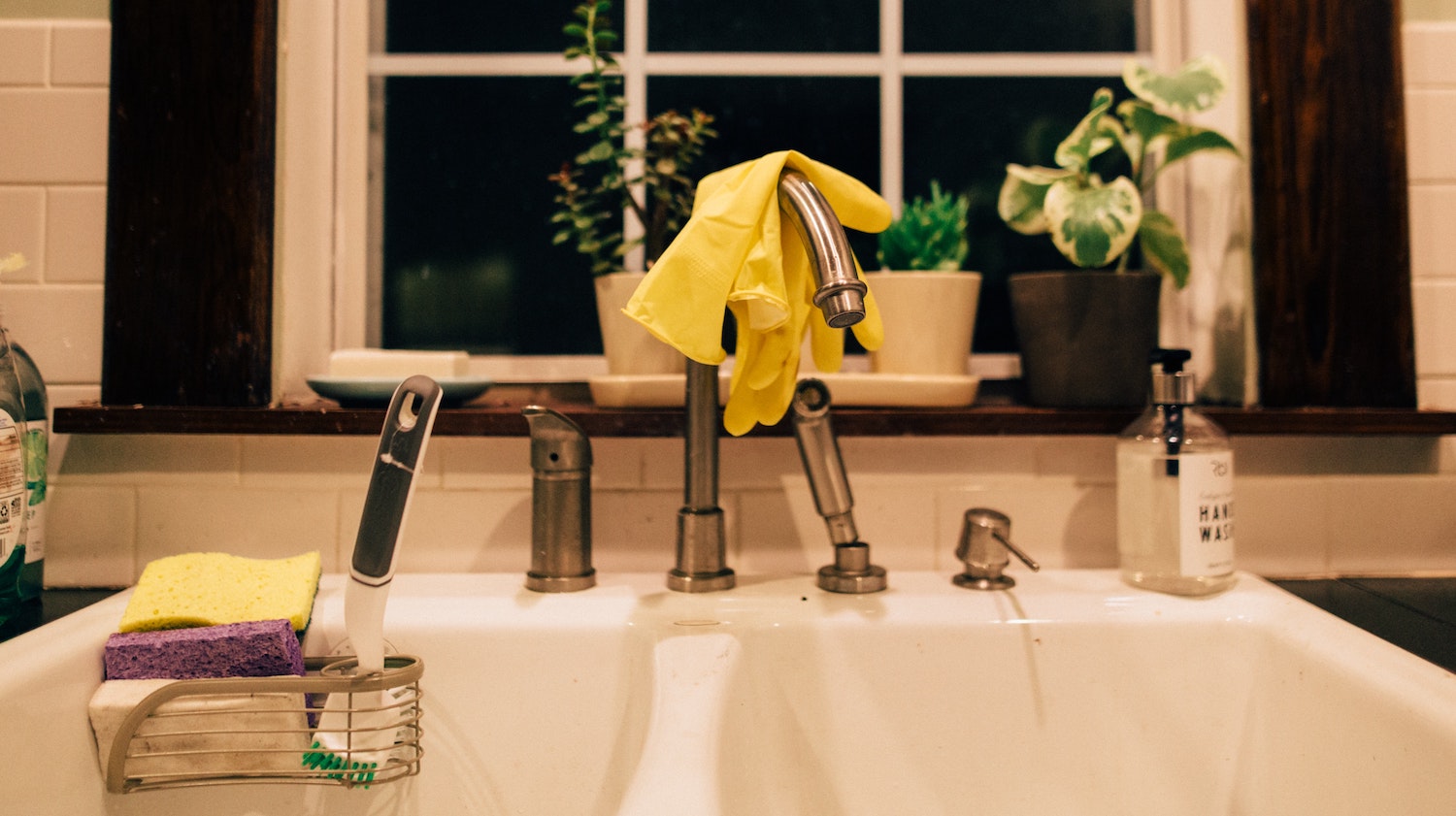How to Clean Kitchen Sink Drain and Waste Disposal Unit

Keeping your kitchen sink, drain, and waste disposal unit sparkling clean can sometimes feel like an uphill battle. But there is a solution.
As we’re about to dive into a guide that will transform your kitchen chores into a piece of cake.
Whether you're dealing with stubborn grime, a stinky drain, or a waste disposal unit that's seen better days, we've got tips and tricks to help you keep them pristine and fresh.
Sit back, put your rubber gloves on standby, pop the kettle on and let's venture into the realm of gleaming sinks and gurgling drains!
How to a Clean Kitchen Sink
To keep your kitchen sink sparkling clean, follow these simple steps:
- Empty the sink: Start by removing any dishes or debris.
- Rinse the sink: Use warm water to rinse the entire surface area of the sink.
- Create a scrubbing paste: Mix a few spoons of baking soda with a little water to create a thick paste. Baking soda is a great natural cleaner that won't scratch your sink.
- Scrub the sink: Apply the baking soda paste to a soft sponge and scrub the entire sink, focusing on areas with tough stains.
- Rinse again: Thoroughly rinse the sink to wash away the paste and loosened grime.
- Shine the sink: For an extra shine, you can wipe the sink with a bit of white vinegar followed by a clean, dry cloth.
- Disinfect the plughole: Pour a mixture of equal parts vinegar and boiling water down the drain to disinfect and clear minor blockages.
- Regular upkeep: Regularly rinse your sink after use and clean it thoroughly once a week to maintain its shine and cleanliness.
Remember, the cleaning process might differ slightly depending on the material of your sink.
Always test your cleaning solution on a small, inconspicuous area first to ensure it doesn't damage the sink material.
Click here to buy kitchen sinks...
How to Clean a Kitchen Sink Drain
Keeping your kitchen sink drain clean is not only crucial for hygiene but also for the smooth functioning of your sink.
Here's how you can do it:
- Boiling Water: The simplest method to start with is pouring a kettle of boiling water down the drain. This often helps to dissolve and flush away minor blockages.
- Baking Soda and Vinegar: If the boiling water doesn't do the trick, try using a combination of baking soda and vinegar. Pour half a cup of baking soda into the drain, followed by half a cup of white vinegar. Let the mixture fizz and work its magic for 15-20 minutes, then rinse with boiling water.
- Plunger: If the blockage persists, a plunger might be needed. Fill the sink with enough water to cover the plunger's base, then place it over the drain and pump vigorously.
- Plumber's Snake or Wire Hanger: For stubborn blockages, you may need a tool to reach into the drain. A plumber's snake is ideal, but a straightened wire hanger can also work. Simply push it down the drain to dislodge the blockage, then rinse with boiling water.
- Seek Professional Help: If all else fails, it might be time to call in a professional plumber. They have the skills and tools necessary to tackle more serious blockages.
Remember, regular maintenance can prevent many blockages.
Try to avoid letting food scraps go down the drain, and consider using a drain strainer to catch any debris.
How to Clean a Waste Disposal Unit in a Sink
Cleaning a waste disposal unit can seem like a daunting task, but it's easier than you might think!
Here's how you can do it:
- Safety First: Always start by switching off the power to the waste disposal unit. This is crucial to ensure your safety throughout the cleaning process.
- Ice and Salt: Pour half a cup of rock salt and a handful of ice cubes into the disposal. Turn on the power and run the disposal until the ice is gone. This will help to remove any grime or debris that's stuck on the blades.
- Baking Soda and Vinegar: Sprinkle half a cup of baking soda into the disposal, then add a cup of white vinegar. Allow it to fizz and sit for 15-20 minutes. This will help to break down any remaining residue.
- Scrub the Unit: Using a long-handled scrubbing brush, scrub under the rubber flaps to ensure all areas of the disposal are clean. Be cautious to avoid any sharp blades.
- Rinse and Deodorise: Rinse the unit with cold water to wash away any remaining debris. To keep your waste disposal smelling fresh, consider adding a few pieces of lemon or lime peel and run the unit with cold water.
Remember, routine maintenance can prevent unpleasant odours and keep your waste disposal working efficiently.
Avoid disposing of items such as bones, coffee grounds, and fibrous materials, which can damage the unit or lead to blockages.
(Click here to see our complete range of kitchen taps for sale online).
How to Unblock a Kitchen Sink Drain Without Nasty Chemicals
If your kitchen sink is clogged and you'd prefer not to use harsh chemicals, here are some eco-friendly steps you can try:
- Boiling Water: This is often the first step and the easiest one. Boil a kettle of water and then slowly pour it down the drain. Be careful not to pour it all at once so that the hot water can work its way through the blockage.
- Plunger: If boiling water doesn't work, you can try a good old-fashioned plunger. Ensure you have a tight seal around the drain and then give it several good pumps. This can often dislodge a clog.
- Baking Soda and Vinegar: This is a well-known natural cleaning solution. Pour half a cup of baking soda down the drain, followed by half a cup of vinegar. Let it sit for at least 20 minutes to break up the blockage, and then rinse with boiling water.
- Manual Removal: If you're feeling brave, and the blockage is close to the surface, you could try removing it manually. You can use a wire coat hanger straightened out to try and fish the blockage out.
- Plumber's Snake or Hand Auger: If the blockage is stubborn or deeper down, a plumber's snake or hand auger can be used to break up the blockage.
Remember, if you're unable to clear the blockage yourself, it may be time to call a professional plumber to avoid damaging your pipes.
Also, routine preventative maintenance, like using a sink strainer to catch large particles and not pouring oil or grease down the drain, can help avoid blockages in the first place.
How to Unblock a Kitchen Sink Drain With Strong Chemicals
If you're dealing with a stubborn clog in your kitchen sink drain and eco-friendly methods have not been successful, you may need to resort to using a chemical drain cleaner.
These are potent solutions designed to break down blockages and they should be used with extreme caution due to their corrosive and toxic nature.
Here's how you can use one:
- Select a Drain Cleaner: Choose a drain cleaner suitable for your pipes. There are various types on the market, and some are specific to certain types of blockages. Make sure to read the product label thoroughly.
- Ensure Proper Ventilation: Open windows or turn on a fan if you're in an enclosed space. Chemical drain cleaners produce fumes which can be harmful if inhaled in large amounts.
- Use Gloves and Eye Protection: These chemicals can cause severe burns if they come into contact with skin or eyes. Ensure you're wearing suitable protective equipment before you begin.
- Follow Instructions: Every drain cleaner will have its own specific instructions on the back of the bottle, detailing how much to use and how long to leave it in the drain. Make sure to follow these to the letter.
- Flush With Water: After the recommended time has passed, flush the drain with hot water to wash away the chemicals and any remnants of the blockage.
- Dispose of the Bottle Safely: Once you've used the drain cleaner, make sure to dispose of the bottle in accordance with local regulations.
Remember, chemical drain cleaners are a last resort and regular use can damage your pipes over time.
If you're frequently experiencing blockages, it might be a sign of a more significant issue, and you should consider calling a professional plumber to inspect your drains.
Can You Buy Kitchen Sinks Online?
Yes you can buy them here direct from our website and the very best possible prices.,
And this includes our exclusive 1810 range of kitchen sinks.
The 1810 range is a UK based company which offers a great range of sinks in all different sizes and shape and finishes.
We have the Belfast sink which is your more traditional sink.
Click here to take a look at our Belfast Sinks.
Then there’s the undermount sink which sits underneath the worktop giving you a nice sleek smooth finish.
This particular range comes in various styles and finishes that will make your kitchen pop.
Check out our undermount sinks here.
We also have the inset sinks, which sit on top of your worktop, these come in various styles, colours and finishes.
Take a look at our inset sinks on this link.
Along with the inset sinks we have the gorgeous fireclay sinks which give your kitchen that rustic look and appeal
Checkout these fireclay kitchen sinks.
Or you can experience a dash of vintage elegance in your kitchen with the beautifully polished ceramic undermount sink.
Its unobtrusive finish seamlessly integrates with your kitchen's aesthetic, offering a timeless touch of class.
Click here to see our ceramic undermount sinks.
Click here to see the full 1810 range.
Tips From an Expert Kitchen Fitter
Over years of experience working with kitchens, I have learned the hard way that it much better to prevent your sink from getting blocked than having to unblock it.
Some blockages can be really tricky (and costly) to fix, then there is the nasty smells and all the hassle.
Trust me you want to void all of this if you can!
So my advice is to make sure you minimise the solid waste going down the drain and regularly use a sink plunger to get the drain clear and running freely.
Keeping on top of it is much better than having to a tradesman to comet and spend a couple of hours fixing your drains!
Final Notes On How to Clean Your Kitchen Sink, Drain and Waste Disposal
In conclusion, maintaining a spotless, sparkling kitchen sink doesn't have to be a daunting task.
It all starts with understanding your sink's material, be it stainless steel, porcelain, granite or composite, as this informs your choice of cleaning method and products.
Regular cleaning is vital to avoid build-up of grime and limescale, and using harsh chemicals should be avoided to preserve the sinks surface.
Rinsing and drying your sink thoroughly after each clean prevents water spots, whilst buffing it using a soft cloth, or even a little baby or olive oil, can achieve that long-lasting shine.
The secret is consistent care and using the right products and methods for your specific sink.


